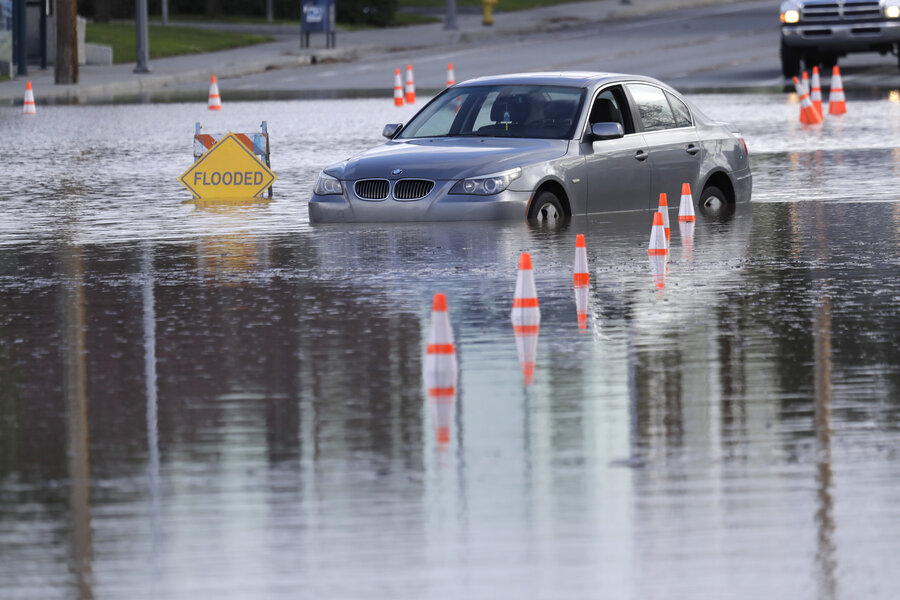Hundreds of San Jose residents rescued from rising floodwaters Tuesday
Loading...
| SAN JOSE, Calif.
Rescuers chest-deep in water steered boats full of people, some with babies and pets, from a San Jose neighborhood inundated Tuesday by water from an overflowing creek.
Further north, farmers used tractors to shore up an endangered levee in California's agricultural heartland, officials opened a spillway at the Don Pedro reservoir for the first time in 20 years, and a Sierra Nevada highway threatened to collapse after the latest downpours swelled waterways, leaving nearly half of the state under flood advisories.
In San Jose, at least 225 residents were taken to dry land and rinsed with soap and water after being in floodwaters from the Coyote Creek that had traveled through engine fuel, garbage, debris and over sewer lines, San Jose Fire Capt. Mitch Matlow said.
Rescuers went door-to-door searching for people who needed to leave the neighborhood. Only residents who could prove they had been cleaned of the floodwaters were allowed to board buses to shelters.
"The water started to seep in the driveway, and then it started to creep up into the front door. It kept getting worse and worse," said Alex Hilario, who walked in knee-high water to get to his car and leave the area.
"We didn't get a chance to get anything out," Hilario added.
Bobby Lee, said he was rescued with his brother and parents, who took clothes, electronics and some photos from their home in a neighborhood that ended up littered with submerged cars.
"This is like once-in-a-lifetime," Lee said.
Earlier Tuesday, firefighters rescued five people stranded by flooding at a homeless camp along the same creek in San Jose.
Firefighters knocked on doors to tell residents to get out of their homes because the city does not have sirens or another emergency warning system, San Jose spokesman David Vossbrink said.
The rains were the latest produced by a series of storms generated by so-called atmospheric rivers that dump massive quantities of Pacific Ocean water on California after carrying it aloft from as far away as Hawaii.
In the Sierra Nevada mountain range, part of Highway 50, one of the main routes to Lake Tahoe, was in danger of collapsing after a roadway shoulder gave way following heavy storms, leaving a gaping hole about 40 feet long and 17 feet wide, Caltrans engineer Jarrett Woodruff said.
Crews opened one lane open Tuesday as Caltrans workers tried to fix the road failure after numerous mudslides blocked it for days at a time in recent weeks.
Heavy storms over the last two weeks caused parts of the shoulder and part of one lane on the four-lane highway give way.
In the San Joaquin Valley in California's agricultural heartland, farmers used their tractors and other heavy equipment to help shore up an endangered levee along the San Joaquin River.
Some farmers took their tractors and other equipment to the levee to help shore it up, arriving to fill a big breach within half an hour of noticing the break, said alfalfa farmer Tony Coit.
"The farmers ran it like a boss," he said, using soil from the levee itself to fill in the 30-foot-wide break until they could truck in large rocks for more substantial repairs.
Water began flowing from the Don Pedro reservoir on the Tuolumne River, for the first time in 20 years, said Calvin Curtin, a spokesman for the Turlock Irrigation District. A stretch of the river flowing through Modesto was just below flood stage, but officials warned small neighborhoods of mobile homes to be alert, and asked some owners to tow their trailers to higher ground. The relief flows from the reservoir are expected through Thursday.
The water level rose at Lake Oroville for the first time since authorities ordered an emergency evacuation of 188,000 people more than a week ago after a damaged spillway caused major flooding concerns.
The rains have saturated the once-drought stricken region and wreaked havoc for residents hit hard by the heavy rain. At least four people have died in the storms throughout the state in the last week.
A motorist in Northern California was swept into a creek Saturday during another in the series of storms and drowned inside her car, the Los Angeles Times reported Tuesday.
Witnesses had seen the woman driving around signs blocking the road near Orland, Undersheriff Todd James of the Glenn County Sheriff's Office told the newspaper.
The current storm system began to weaken Tuesday after dumping more than a half-inch of rain in the San Joaquin Valley, over an inch in San Francisco, and more than five inches in the mountains above Big Sur over the previous 24 hours, the National Weather Service reported.
Dry weather was expected to return to the region on Wednesday.







